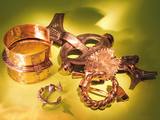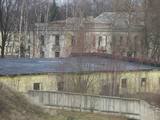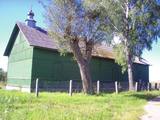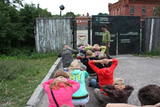| Нo | Название | Описание |
|---|---|---|
|
Музей Малтской 2-й средней школы. Галерея украшений
древних латгальцев 6 – 13 веков.
Время работы: 9.00 – 16.00, Сб.,Воскр.: выходные |
||
|
Atrodas Raganas centrā pie degvielas uzpildes stacijas, viesnīcā „Raganu ligzda”. Piedāvā mūsdienīgu Latvijas virtuves ēdienkarti. Kompleksās pusdienas. Sadarbojas ar vietējām zemnieku saimniecībām. |
||
|
Находится в центре старого города - на перекрестке Латгальской и Церковной улиц. Церковь строили в период с 1843 – 1845 годы в стиле русского классицизма. Недавно восстановлена роспись потолков и стен. В башне храма располагается колокол весом 1667 кг. |
||
|
The brewery is located in Upespils, Suntaži parish, Ogre district. IndieJānis Brewery is one person's foolishness, longing for life and cheerfulness, which is why the owner's main goal when brewing is to create a certain taste, regardless of the cost of the product. Beer can be purchased locally in brewery by prior contact, as well as in pubs - TAKA, Brevings, Zobens un Lemess, Vinilbārs, Alus Muiža, Miezis un kompānija, Valmiermuižas alus vēstniecība. |
||
|
В этом хозяйстве занимаются разведением коз и производством различных продуктов из козьего молока, делая из свежего исходного сырья козий сыр и другую продукцию. На полях хозяйства также растет картофель, сочная клубника и другие продукты. За столом в летней беседке могут с комфортом сесть и пообщаться 15-20 человек. Предлагается легкая еда ‒ на 100 % из продуктов, выращенных и произведенных в хозяйстве. |
||
|
Ресторан – пиццерия «Томато пицца» находится в центре города Елгавы в т/ц «Пилсетас пассажа» («Городской пассаж »). Для приятной трапезы элегантно и уютно обустроены помещения ресторана, лёгкая фоновая музыка и любезный, профессиональный персонал. Предложение «Томато пицца» включает все виды классических пицц, которые приготовлены, используя особые рецепты соуса и характерное для Италии тесто для пиццы. Кроме пиццы предлагаются разные салаты, закуски, супы, пасты, вторые блюда, десерты и напитки. Ресторан – пиццерия «Томато пицца» одновременно подходит как для отдыха в кругу семьи, так и для обеда в атмосфере деловых переговоров. |
||
|
Находится на улице Аугуста, д. 12. Длина камня - 2,8 м, ширина - 2,2 м, а высота - 0,7 м. Он служил пограничным камнем города (места) Краславы, установлен здесь в 1729 году в честь приобретения родом графов Платеров Краславы. По бокам камня высечен герб рода Платеров и уже упомянутое число года. Предания рассказывают, что у камня после охоты обедал король Польши Август II. |
||
|
Маршрут проходит по прекрасным цветочным садам Курземе и Жемайтии. В Кандаве находится самая большая коллекция ирисов. «Миеркални» является крупнейшим садом лилейника в Восточной Европе с более чем 1000 его сортами. Владелец производит также фруктовые и ягодные вина. В природном парке Талсинской возвышенности находятся яблоневые сады Курземниеков, где можно приобрести фрукты или продукты из них (сушеные яблоки, яблочные чипсы, соки). В хозяйстве окружающей среды и здоровья «Упмали» готовят чай, смеси из трав, растительные масла, особые бальзамы, косметику, травяное мыло и т. д. - под маркой Анна Берманс. В Саулескалнском дендрарии находится самая старая в Латвии 50-летняя магнолия. Более 100 сортов пионов выращивают в саду Зиедоню. Владельцы усадьбы Марас предлагают исторические рассказы немецких усадеб района Кулдиги. В молочной усадьбе Бергхоф находится Музей молока. В дендрологическом саду Мара Линде можно найти экзотические сорта цветов и деревьев. В фермерском хозяйстве «Турайдас» производит травяные чаи и чайные мешочки для сувениров или подарков, используя малину, пижму, манжетку, подорожник и цветы липы. В поселке Ница путешественники могут посетить несколько декоративных садов, которые поддерживают местные традиции садоводства. В Руцавском дендрарии можно осмотреть коллекцию магнолий. Самый большой японский сад в Европе (16 га) - это место для коллекции традиционных ароматических растений и овощных культур. Усадьба в Паланге, где расположен Музей янтаря и парк Бирутес является одним из наиболее хорошо сохранившихся усадебных комплексов в Литве. Кретингский усадебный парк - один из старейших усадебных парков 16-18 в. в Литве. В ботаническом саду Клайпедского университета расположен прибрежный этнографический сад с типичными для этой местности сортами цветов. Клайпеда - самый популярный приморский курортный город в Литве. Морской музей и дельфинарий являются одной из самых известных туристических достопримечательностей Клайпеды. В усадьбе Шилуте есть два парка - английский ландшафтный парк с прогулочными дорожками и лесопарк, известный как Варнамишкис или так называемый «Вороний лес». Пакалне - это уникальный традиционный рыбацкий двор с садовыми растениями, характерными для этого региона Литвы. |
||
|
Dabas liegums veidots ezera, tā salu, ainavas, augu, putnu un sikspārņu aizsardzībai. Liegumu var apskatīt "no malas" - no ceļa, kas iet gar tā ziemeļu un ziemeļaustrumu robežu.
|
||
|
The area is in the centre of the Teirumnīki swamp, alongside a lake of the same name. There is a wooden footpath that crosses the swamp (800 metres). This is an excellent opportunity to study a high swamp, a swamp lake, and the surrounding environment.
|
||
|
АО «Прейлю сиерс» является крупнейшим производителем сыра в Латвии, экспортирующим ~ 90 % сыра. В магазине „Preilis”, расположенном недалеко от производства по адресу ул. Даугавпилс 66a, в продаже имеется самый широкий ассортимент продукции АО «Прейлю сиерс». Дегустацию прейльского сыра и просмотр фильма предлагают также в бистро „Preilene” по адресу Прейли, ул. Резекнес 15. В Прейли находится единственный памятник сыру в Латвии (во всем мире только несколько таких). Также в городе можно увидеть шесть сырных скульптур. Прейли называют латвийской столицей сыра. |
||
|
Трактир Kaali на протяжении долгих лет предлагает своим гостям лучшие блюда и напитки эстонской и сааремской кухни, приготовленные из местных продуктов, а также знакомит с культурой и историей острова. Посетители музея и метеоритного кратера Каали могут здесь вкусно перекусить. |
||
|
Iespēja iepazīties ar mājas vīna gatavošanas procesu, un kopā ar Krimuldas muižas vīndari izzināt mājas vīna gatavošanas noslēpumus un degustēt vīnu, kas pagatavots no dažādām ogām. Vīna īstā garša vislabāk atklājas, klausoties stāstus par muižas dzīvi! |
||
|
В Seto Tsäimaja, который относится к Музею народа сету, можно отведать блюда, приготовленные в традиционной глиняной посуде сету, послушать песни сету и игру на народных инструментах. |
||
|
Dodieties ekskursijā, lai gūtu ieskatu lauku profesijā un dzīvesveidā, kā arī iegūtu jaunus iespaidus un labu atpūtu visai klasei. Ekskursijas laikā apmeklējiet saimniecību, kuras galvenā specializācija ir piena lopkopība un graudkopība. Pēc tam izbaudiet pikniku Vilces dabas parkā, kurš ir izvietojies Vilces upītes un tās pieteku gravu krastos. Pie Vilces pilskalna atrodas Zaķu pļava – labiekārtota un iecienīta apmeklētāju atpūtas vieta. Tālāk dodieties uz maizes ceptuvi, lai iepazītos ar maizes cepšanas arodu, degustētu un iegādātos maiznīcas izstrādājumus. Ekskursijas noslēgumā apmeklējiet saimniecību, kur audzē graudaugus un kartupeļus, piedāvā apskatīt senu darba rīku un piena pārstrādes iekārtu kolekciju un praktiski darboties ar tiem. Bērni var atpūsties un pavadīt brīvo laiku atrakciju parkā. |
||
|
На месте теперешней Даугавгривской крепости первое укрепление построила шведская армия в 1608 году во время польско-шведской войны. В сороковых годах 17 столетия шведская армия возвела здесь современную по тем временам крепость с пятью бастионами и двумя воротами. На вооружении крепости находилось 120 пушек и мортиры, внутри располагались солдатские казармы, квартиры офицеров, гарнизонная церковь, продовольственные и оружейные склады. В результате Северной войны в 1710 году крепость перешла к Русской армии. И после оккупации Латвии в 1940 году здесь располагались единицы Военно-морского флота СССР. К сожалению, уникальный исторический памятник, находящийся в столице государства, в настоящее время публично не доступен. Довольно приблизительное представление об историческом памятнике можно получить при наружном осмотре объекта, откуда просматривается кладка, бастионы, крепостной ров и небольшая часть старой церкви. Рядом с крепостью находится армейская часть бывшего СССР с покинутыми зданиями и памятниками воинам-подводникам.
|
||
|
Mоленная Кампишкской старообрядческой общины
реконструирована в 1931 году по плану архитектора В. Шервинс-
кого. Храм высокий, просторный и с двумя кельями. В западной
части высокая колокольня, которую украшает крест.
|
||
|
Расположенов центральной части Екабпилса, ул. А. Пормаля, 11. Здание построено в 1931 году в стиле классицизма и до сегодняшних дней сохранило свой оригинальный банковский интерьер. Сейчас здесь разместился Екабпилсский филиал банка SEB. |
||
|
Aktīvās atpūtas parka “Godiņu Piedzīvojumu Platforma” piedāvā organizētus pārgājienus, ejot ar kājām, braucot ar velo, nūjojot, skrienot, vienam, ar draugiem, ar ģimeni, ar kolēģiem, ar četrkājaino draugu. Venlaikus ir iespēja baudīt koka flautas brīnumainās skaņas meža ielokā un pašam izgatavot savu pūšaminstrumentu. |
||
|
Тюрьму военного порта не стоит описывать. Это надо пережить и выжить! И такая возможность предоставляется каждому. На сегодняшний момент это наилучший туристический продукт военного наследия, учиться на примере которого может любой.
|
||























